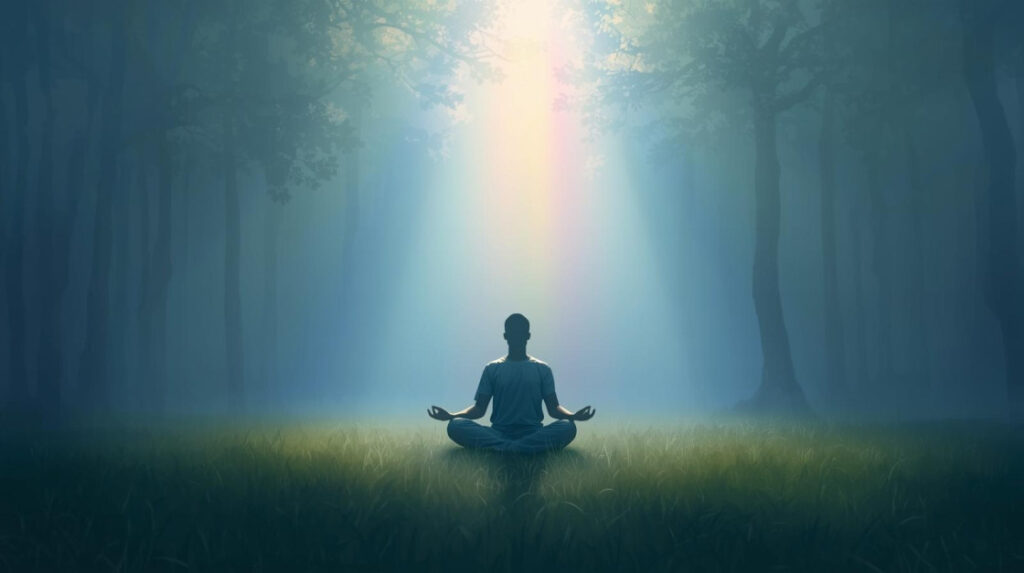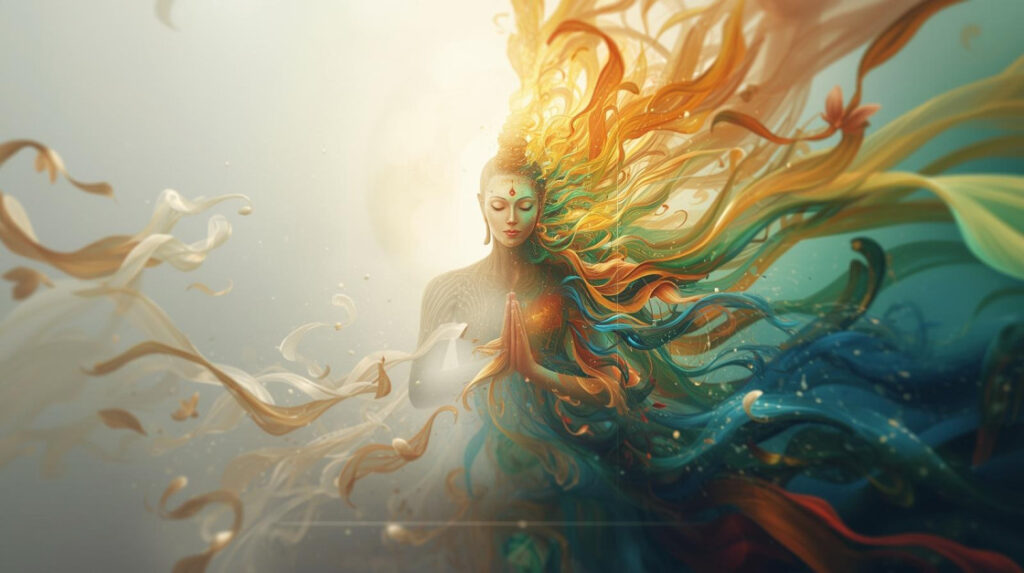
Within the Indian custom, Darshan will not be a set of inflexible beliefs, however a approach of seeing. Every system of philosophy is sort of a lens via which reality is approached serving to us to know life, actuality, and the character of the Self. The phrase Darshan itself means “imaginative and prescient,” a direct seeing that transforms each the outer world and our internal being.
Amongst these paths, Yoga shines as each technique and vacation spot. It’s greater than postures or self-discipline; it’s the motion from restlessness to stillness, from separation to union. Yoga leads us again to the Atman, the unchanging Self, the place readability, peace, and freedom naturally come up past the turbulence of worldly change.
Samkhya gives the discriminative knowledge to recognise the everlasting witness (Purusha) aside from the ever-changing play of nature (Prakriti). The Vedic and Tantric traditions deepen this journey via devotion, ritual, and direct expertise. Even the so-called atheistic colleges remind us that cause and inquiry can also develop into sacred instruments on the trail of self-knowledge.
On this article, we’ll stroll via these various teachings — not as summary theories, however as dwelling insights that proceed to information the seeker in direction of internal imaginative and prescient and self-realisation.
Indian philosophy (Darshan): some ways of seeing actuality
The phrase Darshan means “imaginative and prescient” or “approach of seeing.” In Indian thought, philosophy will not be a set of inflexible doctrines however a set of views that assist us perceive life and actuality. Every Darshan capabilities like a lens, providing a novel view of reality.
What makes Indian philosophy particular is its range and concord. There are theistic colleges, which settle for God, and atheistic colleges, which don’t. But they coexist, providing complementary insights as an alternative of competing for dominance.
Consider it like a prism of sunshine. Every philosophy shines on a special spectrum of reality: some give attention to the Self and consciousness, others on nature and matter, and a few emphasise data, apply, or direct expertise.
Sensible Perception for yoga practitioners
Understanding Darshan reminds us that there’s no single path to reality. In your yoga apply, this implies you’ll be able to discover totally different kinds and philosophies, discovering what resonates most deeply along with your thoughts, physique, and coronary heart.
The which means of yoga in philosophy
In Indian philosophy, Yoga means union. It isn’t restricted to postures or bodily train, however refers to any apply that unites us with the Self, with others, or with greater reality.
Yoga is known in two methods:
- As a course of – the practices themselves, similar to meditation, pranayama (breath management), or self-discipline.
- As a state – the last word objective of liberation (kaivalya), when the thoughts turns into nonetheless and we relaxation in our true nature (typically known as the Self or Purusha).
The objective of Yoga is to not merge with the altering world exterior, however to unite with the Atman, the unchanging Self inside. This brings peace, readability, and freedom from life’s fluctuations.
Residing Yoga in Each day Life
Even throughout easy asanas or meditation, keep in mind that yoga is about observing quite than reacting. Whether or not via Bhakti Yoga (devotion), Karma Yoga (motion), or Jnana Yoga (data), the last word objective is the internal union that underlies each apply.
Samkhya philosophy: the observer and the noticed

Among the many six classical colleges, Samkhya provides a transparent framework for understanding existence and kinds the inspiration of Patanjali’s Yoga Sutras.
Samkhya explains life via two elementary rules:
- Purusha (The Observer): Pure consciousness, the everlasting witness. Unchanging, inactive, and unseen—like silent mild that makes expertise doable.
- Prakriti (The Noticed): Nature, matter, and all that adjustments, together with the physique, ideas, feelings, and the exterior world.
Human struggling arises once we mistake Prakriti for our true self. We establish with our physique, thoughts, or feelings, forgetting the deeper Self.
Yoga, from the Samkhya perspective, is the apply of disentangling from Prakriti and resting in Purusha. By way of regular effort (abhyasa) and detachment (vairagya), we realise
“You aren’t your physique, not your ache, not even your ideas—you’re the witness of all of them.”
Practising Samkhya in Each day Yoga
Throughout meditation or mindfulness apply, observe ideas and sensations with out attachment. It is a direct option to expertise the Samkhya distinction between Purusha and Prakriti.
Vedic vs. Tantric data: two complementary paths
Within the yogic custom, knowledge flows via two complementary streams: Vedic and Tantric.
- Vedic Data (Deductive): The Vedas are revealed knowledge, handed down by enlightened seers (Rishis). This information begins with the very best reality and explains it to seekers, offering the philosophical framework.
- Tantric Data (Inductive): Tantra emphasises direct expertise. As an alternative of describing hearth, a trainer could information you to really feel its heat. Tantric practices work with power, the physique, and sensible strategies to awaken greater states of consciousness, seen in Hatha Yoga, Kundalini Yoga, and Kriya Yoga.
Although generally seen as opposites, these paths are complementary. Vedic knowledge sharpens the thoughts, whereas Tantra awakens the physique and coronary heart. Collectively, they steadiness data and apply, like idea and experiment in science.
Yoga perception
Mix examine and reflection with bodily and energetic apply. Philosophy guides understanding, whereas expertise confirms it in your individual physique and thoughts.
The worth of atheistic philosophy
Indian philosophy additionally makes house for atheistic colleges, similar to Samkhya, Buddhism, and Jainism, which don’t depend on a private God. As an alternative, they emphasise cause, remark, and direct expertise.
This questioning angle strengthens understanding. Samkhya, as an illustration, asks us to fastidiously examine the distinction between Purusha and Prakriti, exhibiting that reality could be found via readability and logic.
Perception for Yoga Practitioners
In your individual apply, domesticate this similar spirit of self-inquiry. Observe the actions of the thoughts, query ordinary reactions, and discover consciousness instantly. Just like the non-theistic colleges, strategy yoga not as blind perception, however as a dwelling inquiry into the character of the Self.
Historic context and open-ended inquiry
The roots of Indian philosophy and yoga stretch again 1000’s of years, with its foundational concepts creating and being systematized over centuries. Key ideas of Samkhya, as an illustration, seem in historical texts just like the Upanishads (c. Eighth-Sixth centuries BCE) and are absolutely elaborated within the classical Samkhya Karika (c. 4th century CE).
Teachings have been typically shared via dialogues, tales, and practices, not mounted doctrines. This displays the open-ended nature of Indian philosophy it invitations each seeker to ask questions, replicate, and kind private understanding.
Yoga perception
Every yoga apply is a part of this ongoing inquiry. Whether or not via devotion, reasoning, or direct apply, your journey is private and evolving, simply because the philosophy itself has for millennia.
Conclusion
Indian philosophy (Darshan) is a dwelling dialogue, providing a number of methods to see and perceive actuality. Yoga serves as each path and objective, guiding us to unite with the unchanging Self past the fluctuations of the world.
By way of Samkhya, we be taught to differentiate Purusha from Prakriti. By way of Vedic and Tantric teachings, we steadiness philosophy and expertise. By way of atheistic inquiry, we see that cause, doubt, and religion can coexist as instruments for self-discovery.
In essence, Indian philosophy invitations every seeker to replicate, query, and expertise reality, revealing a timeless path to internal readability, peace, and liberation.

